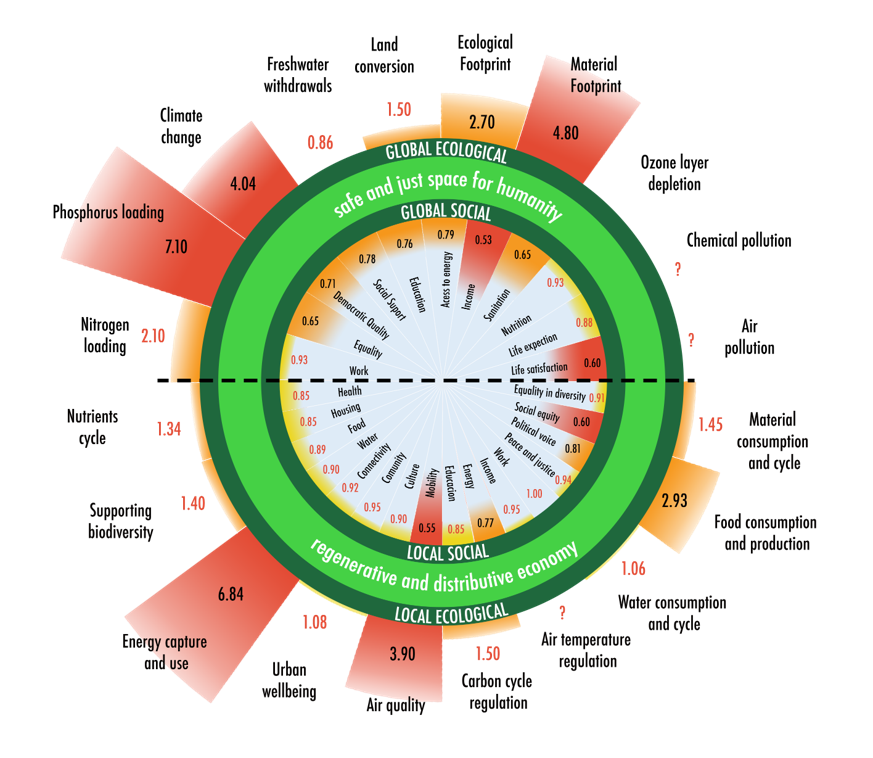
Why this matters
Cities are at the heart of the sustainability transition. They concentrate people, infrastructure, and political power, but also consume a disproportionate share of global resources and generate significant environmental impacts. If the world is to stay within planetary boundaries while ensuring decent lives for all, cities must learn to operate within social and ecological limits. Yet most urban planning tools today remain rooted in economic growth paradigms (i.e. following the well-known motto: ‘the city as a growth machine’). This creates a gap between sustainability rhetoric and real-world governance. Bridging this gap requires new frameworks, indicators, and participatory tools. One such approach is Doughnut Economics.
New research from Barcelona
In a recent study, which was published in the journal Ecological Economics, we examine what happens when the Doughnut Economics framework is applied to a real city: Barcelona. The article offers a detailed account of how we co-developed a “City Portrait” for Barcelona by adapting the methodology created by the Doughnut Economics Action Lab (DEAL), lead by Kate Raworth and Andrew Fanning.
How the City Doughnut was created
We assessed the city’s performance across four interlinked lenses: Local Social, Local Ecological, Global Social, and Global Ecological. These dimensions combine the UN Sustainable Development Goals and the planetary boundaries framework. Through participatory workshops and expert consultations involving over 50 stakeholders, we selected and refined more than 150 indicators to evaluate Barcelona’s performance. Our methodological innovation was the construction of a “re-rolled doughnut” diagram that visually synthesises these dimensions in a single image, enabling users to identify key trade-offs and policy tensions (see Figure 1).
The findings are sobering. While Barcelona performs reasonably well in areas such as healthcare and education, the city exceeds ecological thresholds in domains like greenhouse gas emissions, material use, and nitrogen cycles. Access to green space and environmental justice also emerged as major local gaps. More importantly, the global lenses revealed how urban consumption in Barcelona depends on resource-intensive supply chains, generating impacts well beyond city limits.

Source: own elaboration.
Science-policy challenges and insights
Developing the City Doughnut was not just a technical task. It required balancing scientific rigour, data availability, and political feasibility. Some indicators were excluded due to lack of localised data or their politically sensitive nature. Still, the process helped create space for more reflective conversations about urban priorities. The Doughnut functioned as a boundary object: a shared framework that enabled dialogue across disciplines and municipality departments, and opened up new thinking around justice, distribution, and global responsibility.
A contribution to the post-growth urban agenda
This study contributes to the emerging agenda of post-growth urbanism and ecological economics in practice. Cities are increasingly seen as sites of both unsustainability and transformation. In this context, the Barcelona City Doughnut offers a grounded example of how urban planning can shift from GDP-focused models to more holistic approaches to wellbeing and sustainability. In our previous work on urbanizing degrowth, we argued for the need to reframe urban governance using post-growth principles. The City Doughnut builds on this by offering a practical tool to implement such a shift, anchoring it in participatory governance, multi-dimensional indicators, and global-local accountability.
Implications for the MAPS project
This case study contributes directly to the MAPS project by advancing its core objective of identifying and testing post-growth pathways to sustainability. In particular, it offers a concrete example of how local governments can use alternative indicators and participatory processes to assess ecological and social performance without relying on GDP growth. The methodological innovations developed in this article – such as the integration of global and local dimensions and the participatory selection of indicators- provide valuable insights for MAPS’s ongoing work on sustainable wellbeing metrics, multi-level governance, and transformative policy tools.
Read the full article in Ecological Economics below:
The full article may be cited as:
Cattaneo, C., Hanbury Lemos, M.M., Humpert, V., Montlleó, M., Tello, E., Demaria, F. (2025). Ecological economics into action: Lessons from the Barcelona City doughnut. Ecological Economics, 236, 108667. https://doi.org/10.1016/j.ecolecon.2025.108667

